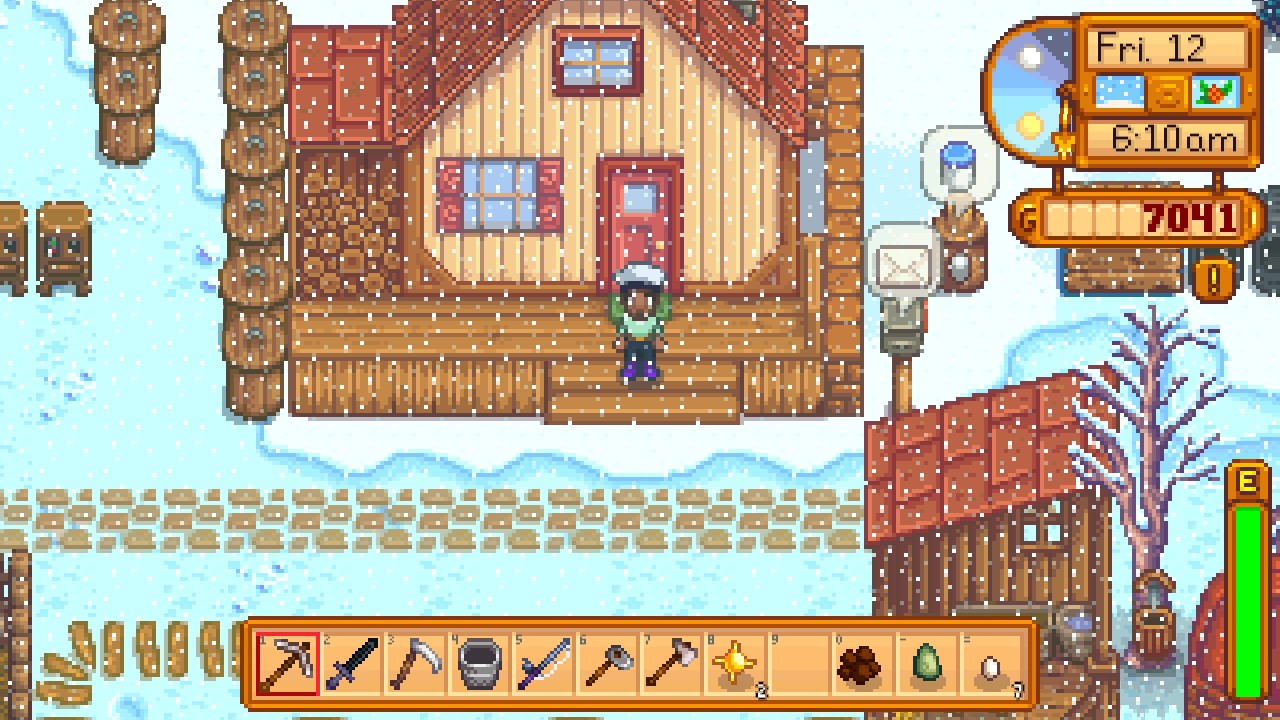Stardew Valley
Mar 29, 2016 · peterb · 4 minute readGames
Stardew Valley is a Windows game that is a labor of love. Designed and implemented by a single developer (with the disarming moniker “ConcernedApe”), the game bills itself as “an open-ended country-life RPG”. What does that mean?
In practice, it means many of the game mechanics of Harvest Moon, combined with story beats from Earthbound and friendship mechanics from Animal Crossing. The game is presented in 1990s-style pixel art graphics and chiptune-style music - it would look and sound right at home on a Super Nintendo system.
The premise is that you flee your soulless job when you inherit a small, abandoned farmstead in Stardew Valley, near the village of Pelican Town. You will redevelop the farm, become a member of the community, and learn the joys of a quiet rural lifestyle. (The irony that you will do this by playing a videogame is thick, but let’s set that aside and play the ball at it lays. We can also set aside the fact that working as a farmer is miserably hard and, often, financially unrewarding work.)
The game is relaxed and charming. On any given day you can maintain your farm (plant, water, or harvest crops, care for livestock, clear out overgrowth), go fishing, forage for wild berries and nuts, set up crab pots, explore the nearby mines (complete with monsters), donate relics and minerals to the town museum, or read a book in the library. Alternatively, you can spend some time getting to know the residents of Pelican Town, by talking with them or giving them gifts. As you become closer to them, you’ll experience cut scenes that let you learn more about them and their day to day lives.

There is very little pressure to engage in any particular activities on any specific timetable. The major clock is that of the seasons. The year in Stardew Valley is divided into spring, summer, fall, and winter, each lasting 28 days. Different crops grow in each season, and each crop takes a different amount of time to grow, but other than that constraint your time is your own. Several times per month there will be a festival of some sort, which you can choose to participate in, or not.
The game, in other words, is largely self-directed. There are certain constants - collect more things, make more money, construct more buildings - but within that framework you have a lot of flexibility to pursue what interests you on any particular day. And that feels pretty darn nice. The game does have quests of several types - in-game assignments given by various characters, and also a more mysterious collection meta-game associated with what I mentally call the “Mr. Saturn Meets Totoro” plot-line. But the pressure to get through these is nonexistent. You can ignore them for months (and I have).
There are about 30-some NPCs who you can get to know. Of these, 10 are single and can be romanced and married (the game lets a million flowers bloom here, and the player can marry any NPC regardless of gender.) Each marryable NPC’s background and story is different - although nearly all are white, which is disappointing - and I quickly found myself wanting to know more about all of them.
The only criticism I have of the game - and it’s a minor one - is that the game saves once per day, when your character goes to bed, and at no other time. This has led to the typical poorly-designed-save-system situation where I, the human want to stop playing, but my choices are limited to “finish the day” or “quit anyway and lose my progress”. A Stardew Valley day is not unbearably long, but this is still a fairly annoying wart on an otherwise extremely forgiving game.
While the game only runs natively on Windows, I was able to run it on a Mac by settin up a Wine container for it quite easily, following these instructions. At $15 on Steam, if you’re looking for something low pressure and play-when-you-want, I recommend it whole-heartedly.